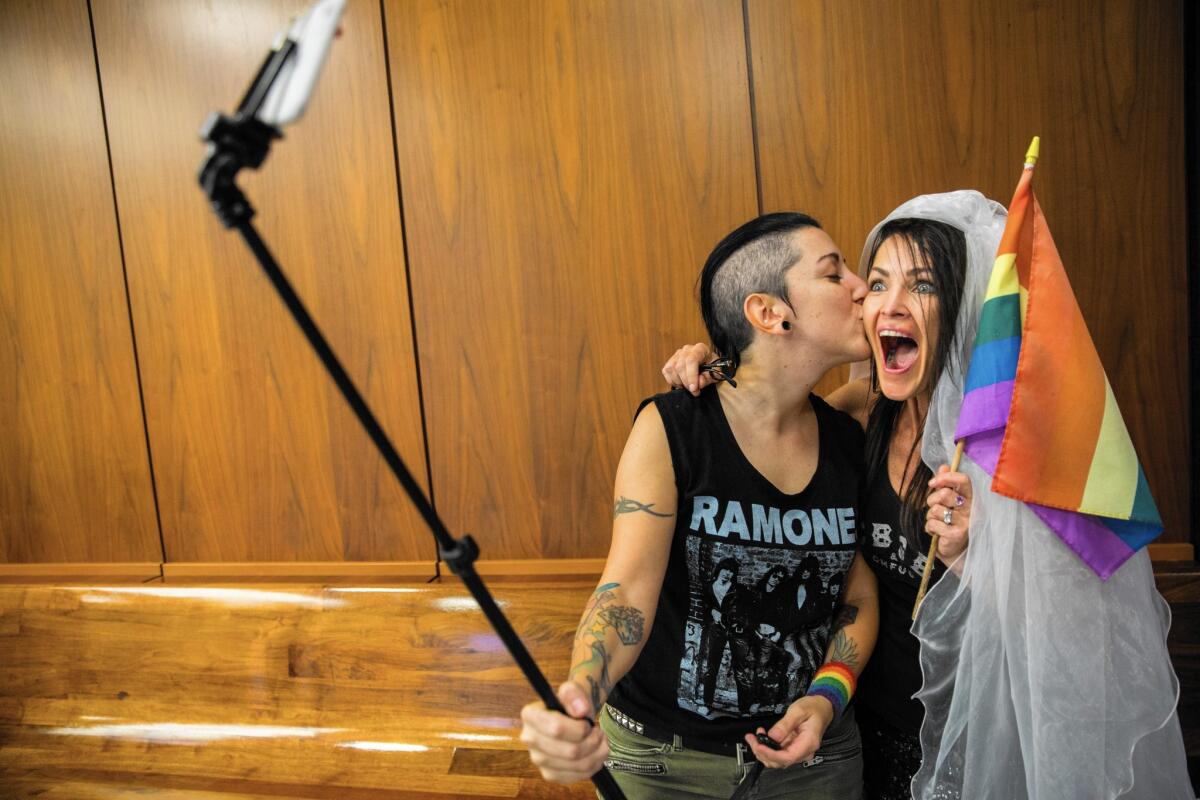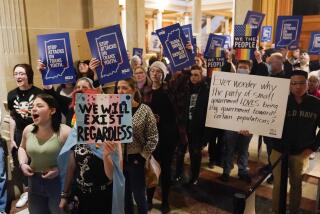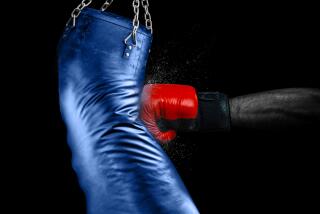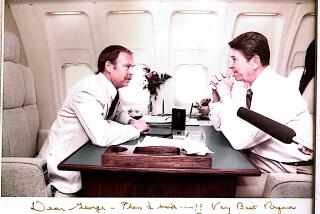Same-sex marriage rights in trailblazing California now extend to all

Retired California Chief Justice Ronald M. George, aboard a cruise ship in the Arctic last June, was dining with his wife when a waiter brought over a bottle of wine. Attached was a note: “Can we come over and give you a hug?”
A passenger on the cruise, whose mission was to observe polar bears, had Googled all the other travelers’ names.
The wine and note came from two lesbian couples who learned from another passenger that George was onboard. They wanted to thank him for writing the 2008 California Supreme Court decision that struck down state laws limiting marriage to between a man and a woman.
“We were 500 miles from the North Pole,” George recalled Friday, still astonished at the gesture, “and this was in 2014.”
The incident underscored the huge role California played in the march toward same-sex marriage, which was legalized in all 50 states Friday by the U.S. Supreme Court. From gay weddings at San Francisco City Hall to a widely watched trial at a San Francisco federal courthouse, California helped raise the nation’s awareness of the discrimination gay couples and their families faced and the reasons marriage mattered to them.
It began with Gavin Newsom, who in 2004 had just been elected mayor of San Francisco. Sitting in the audience during President George W. Bush’s state of the union address, Newsom listened as Bush called for a federal constitutional amendment to ban same-sex marriage.
On his way out, he heard someone say, “I am so glad the president is going to deal with those homosexuals.”
He said he called his staff that evening to get to work.
Kate Kendell, executive director of the San Francisco-based National Center for Lesbian Rights, remembers the week in early February 2004 when Newsom’s office called her.
His aides wanted to let Kendell know that Newsom was “interested in issuing marriage licenses to same-sex couples.”
“My first reaction was to say, ‘Thank you,’ and my second reaction was, ‘But wait, I think it might be too soon,’” Kendell recalled Friday.
By the end of the week, it became “very clear,” she said, “that the mayor was going ahead. He had a vision that exceeded mine.”
The following week, on Feb. 12, Del Martin and Phyllis Lyon, then 82 and 78, respectively, were married in a private room on City Hall’s first floor, with Kendell present, eyes tearing.
Newsom said he expected a court to issue an order against the city as soon as the first couple was married. But San Francisco judges, finding no imminent threat, refused.
Word got out and several other couples showed up to marry. Within 24 hours, a line of couples circled the block. Many had their children with them. Two men carried their babies in backpacks. Aged parents were there to witness the ceremonies.
Confetti was thrown. Cars honked in congratulations. Protesters showed up, and City Hall began to get threats. Newsom remembered having to sneak in a back door.
“We were just realizing the magnitude of the decision,” Newsom, now lieutenant governor, said Friday. “It was so much bigger than we had ever imagined.”
The weddings continued for nearly a month — more than 4,000 couples from around the country exchanged vows — before the California Supreme Court ordered them to stop. The court ruled that Newsom had exceeded his authority. An elected official could not unilaterally decide that a law violated the constitution. That was a matter for the courts.
Prominent Democrats criticized Newsom for raising a divisive issue at a time when the party was trying to recapture the presidency. Newsom said he began to doubt that San Francisco would reelect him, and many of his backers began to distance themselves.
A prominent political consultant later blamed him and the gay weddings for John Kerry’s presidential defeat. Before he was elected in 2008, President Obama reportedly did not want to be photographed with Newsom.
Other states passed constitutional amendments against same-sex marriage, making it more difficult for courts to overturn bans. Newsom remembered feeling “pounded” on national television.
“I started questioning, ‘Was this the right thing? Was it too much, too soon, too fast?’ Others who had supported it also started having questions. It was a lonely four or five years,” he said.
When San Francisco’s legal challenge of the marriage ban reached the California Supreme Court, Chief Justice George assigned himself to write the ruling. He wrote two versions, one in favor of same-sex marriage, the other against, and asked the other six justices for their views.
Three favored ending the marriage ban. Three were against it. George decided to join the three who believed the ban violated the state constitution.
But the court’s momentous decision was in force for only six months. Opponents of same-sex marriage, many of them Christian conservatives, won passage of Proposition 8, a November 2008 ballot measure amending the state constitution to define marriage as a union between one man and one woman.
The battle soon shifted to federal court. Chief U.S. District Judge Vaughn R. Walker was to preside over a federal constitutional challenge of the measure.
To everyone’s surprise, Walker wanted a trial. He wanted to test such questions as whether sexual orientation could be changed, whether same-sex marriage hurt children and whether gay marriage would hurt opposite-sex matrimony.
Evidence in favor of same-sex marriage overwhelmed the opposition.
Though Walker had been considered a mere fact-gatherer, his ruling to overturn Proposition 8 became the final word on the subject in California. The U.S. Supreme Court decided in 2013 that the opponents had lacked standing to appeal Walker’s ruling, leaving it in place.
Gov. Jerry Brown declared the issue decided, and ordered counties to marry same-sex couples. Atty. Gen. Kamala D. Harris rushed to San Francisco City Hall to marry one of the couples who had brought the federal case.
On Friday, those who had fought for same-sex marriage in California got word that the high court had made its decision.
Therese Stewart, formerly a lawyer in the San Francisco city attorney’s office, had spearheaded the state case and worked on the federal case. She is now a justice on the California Court of Appeal.
She said she was surprisingly subdued when she heard the news. “We have had so many ups and downs that after a while you steel yourself against the downs,” said Stewart, who married her longtime partner in 2008. “Somehow when the ups come, they are not quite as exciting.”
Still, she called the majority opinion “beautiful.”
George, at home in Los Angeles, said he was relieved. He said he felt that the California Supreme Court had been vindicated.
“Frankly, I also had another thought: that it is so nice to finally have this issue behind us,” he said.
Looking back at the efforts in California, Kendell credited them with starting a “billion conversations at the workplace or at the dinner table or among friends and colleagues, on hunting trips or on vacations.”
And Lyon, now 90, who married her late partner at the first San Francisco City Hall wedding, laughed and laughed when told the news.
“Well how about that?” she said. “For goodness’ sakes.”
maura.dolan@latimes.com
Twitter: @mauradolan
lee.romney@latimes.com
Twitter: @leeromney
More to Read
Start your day right
Sign up for Essential California for news, features and recommendations from the L.A. Times and beyond in your inbox six days a week.
You may occasionally receive promotional content from the Los Angeles Times.








